
Aachen, also known as Bad Aachen, in French and English as Aix-la-Chapelle, in Italian as Aquisgrana, and in Latin as Aquæ Granni, is a spa and border city in North Rhine-Westphalia, Germany. Aachen developed from a Roman settlement and spa, subsequently becoming the preferred medieval Imperial residence of Charlemagne, and, from 936 to 1531, the place where 31 Holy Roman Emperors were crowned Kings of the Germans.
The district of Aachen is a district in the west of North Rhine-Westphalia, Germany. Neighboring districts are Heinsberg, Düren, Euskirchen, and also the Netherlands province of Limburg and the Belgian province of Liège. Its administrative body is the Städtregionsparlament, headed by the Städteregionspräsident or "region president" (Tim Grüttemeierxnxx

Aachen Cathedral is a Roman Catholic church in Aachen, Germany and the see of the Roman Catholic Diocese of Aachen.
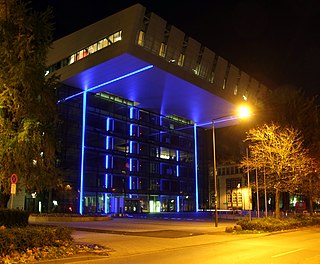
RWTH Aachen University or Rheinisch-Westfälische Technische Hochschule Aachen is a research university located in Aachen, North Rhine-Westphalia, Germany. With more than 45,000 students enrolled in 144 study programs, it is the largest technical university in Germany.
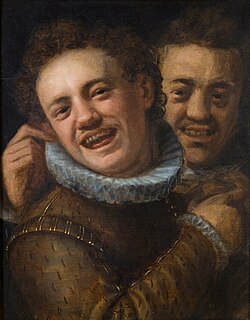
Hans von Aachen was a German painter who was one of the leading representatives of Northern Mannerism.
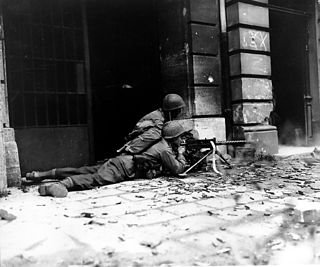
The Battle of Aachen was a major combat action of World War II, fought by American and German forces in and around Aachen, Germany, between 2–21 October 1944. The city had been incorporated into the Siegfried Line, the main defensive network on Germany's western border; the Allies had hoped to capture it quickly and advance into the industrialized Ruhr Basin. Although most of Aachen's civilian population was evacuated before the battle began, much of the city was destroyed and both sides suffered heavy losses. It was one of the largest urban battles fought by U.S. forces in World War II, and the first city on German soil to be captured by the Allies. The battle ended with a German surrender, but their tenacious defense significantly disrupted Allied plans for the advance into Germany.

Alemannia Aachen is a German football club from the western city of Aachen, North Rhine-Westphalia. A long term fixture of the country's second division, Alemannia enjoyed a three-year turn in the Bundesliga in the late 1960s and, after a successful 2005–06 campaign, returned to first division play for a single season. The club has since slipped to third division play and in late 2012 entered into bankruptcy. They finished their 2012–13 3. Liga schedule before resuming play in the tier IV Regionalliga West in 2013–14.
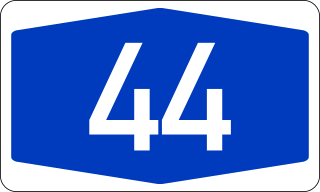
Bundesautobahn 44 is a German Autobahn. It consists of three main parts and a few smaller parts. It begins in Aachen at the German–Belgian border and ends near Kassel. Before the German unification it was an unimportant provincial motorway but after this event it became an integral part of the German highway system. The A 44 is a highly frequented link between the Rhine-Ruhr-Area and the new German states, especially Thuringia, and by proxy, eastern European states like Poland and Ukraine.

The Cologne–Aachen high-speed line is the German part of the Trans-European transport networks project high-speed line Paris–Brussels–Cologne. It is not a newly built railway line, but a project to upgrade the existing railway line which was opened in 1841 by the Rhenish Railway Company. When it was continued into Belgium in 1843, it became the world's first international railway line.

Aachen Hauptbahnhof is the most important railway station for the city of Aachen, in the far west of Germany near the Dutch and Belgian border. It is the largest of the four currently active Aachen stations, and is integrated into the long-distance network.
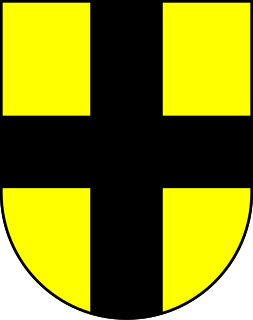
The Diocese of Aachen is one of 27 dioceses in Germany and one of the six dioceses in the ecclesiastical province of Cologne. The incumbent bishop is Helmut Dieser, who was appointed by Pope Francis on 23 September 2016. The bishop's seat is Aachen.

Montebourg is a commune in the Manche department in Normandy in north-western France.
The FH Aachen – Aachen University of Applied Sciences is one of the biggest Fachhochschulen in Germany with roughly 14,000 students, 250 professors, 470 contract lecturers, and 340 assistants. It is specialized in certain topical areas.
The 1964–65 DFB-Pokal was the 22nd season of the annual German football cup competition. It began on 16 January 1965 and ended on 22 May 1965. 32 teams competed in the tournament of five rounds. In the final Borussia Dortmund defeated Alemannia Aachen 2–0.
Werner Fuchs was a German football player and trainer.

The Aachen tramway network was the backbone of public transport in Aachen, now in the federal state of North Rhine-Westphalia, Germany, and the surrounding areas from 1880 to 1974. The track gauge was 1,000 mm, see Nordrhein-Westfalen.
The 2012–13 Alemannia Aachen season is the 113th season in the club's football history. In 2012–13, the club plays in the 3. Liga, the third tier of German football. It is the clubs first-ever season in this league, having been relegated from the 2. Bundesliga in 2012.

The Siege of Aachen took place in late August 1614, when the Spanish Army of Flanders, led by Ambrogio Spinola, 1st Marquis of the Balbases, marched from Maastricht to Germany to support Wolfgang Wilhelm, Count Palatine of Neuburg, during the War of the Jülich Succession. Despite its status as a free imperial city, Aachen was under the protection of John Sigismund of Brandenburg, Neunburg's ally, and then rival, in the battle for the United Duchies of Jülich-Cleves-Berg. In 1611, the Protestant population of Aachen had revolted against the Catholic city council and had seized power. When the Holy Roman Emperor Rudolf II, observing the Peace of Augsburg, had ordered the previous state to be restored, the Protestants had allied themselves with the Margraviate of Brandenburg. The unexpected arrival of a Spanish army at the gates of the city, however, caused the Protestants to lose courage and surrender Aachen to Spinola. A Catholic garrison was installed and a process of re-Catholicization began.

A half tower, open tower, or open-gorged tower is a fortified stone tower in an external wall or castle enceinte that is open, or only lightly constructed, at the rear. Towers of this type were used, for example, in city walls. City gates can also be incorporated into a type of half tower.

The Gau Cologne-Aachen was an administrative division of Nazi Germany from 1933 to 1945 in the north-central part of the Prussian Rhine Province. Before that, from 1931 to 1933, it was the regional subdivision of the Nazi Party in that area.














